
The secret sauce: Why employee wellbeing is more important than ever
Employee wellbeing has become a major game changer in today’s corporate world. Nurturing and sustaining a happy and healthy workforce creates a foundation for future business success. It’s a simple formula – when employees feel good, they are able to handle stress better, find focus, untap creativity and have a meaningful impact on their team and organization. Before implementing a wellbeing program at work, it’s imperative for organizations today to understand employee wellbeing from a holistic perspective. We recently ran a global survey at Mindspace to better understand what influences the physical and mental health of office workers, and the resulting insights provide a guideline for how companies can foster a culture of wellness.

What is employee wellbeing?
Based on Oxford English Dictionary’s definition of well-being, employee wellbeing is the state of a worker being healthy, happy, or prosperous, taking into account their physical, psychological or moral welfare. And it’s true, employee wellbeing encompasses a wide range of mental, physical, financial and social factors.
Previously, employers focused on physical health as the main measure of employee wellbeing, but greater awareness for emotional health amidst rising rates of depression and anxiety have changed that. In fact, an employee’s wellbeing is influenced by many factors including work relationships, leadership styles, pay, access to resources – and overwhelmingly, a growing need for flexibility in how, where and when they work.
Our recently published employee wellbeing insights, based on a global survey of 2,000 employees, shows a significant shift in workplace wellbeing trends. An astonishing nine out of ten employees consider wellbeing facilities and options a critical factor in choosing where to work, and 82% expect support from employers with work-life balance. This indicates that employee wellbeing has a significant impact on employee retention and in establishing attractive (and competitive) employer branding. Surprisingly, however, feedback also showed that a third of companies are not offering any wellbeing options or wellness programs at all, representing a lost opportunity for businesses. Get our complete global employee wellbeing report right here.
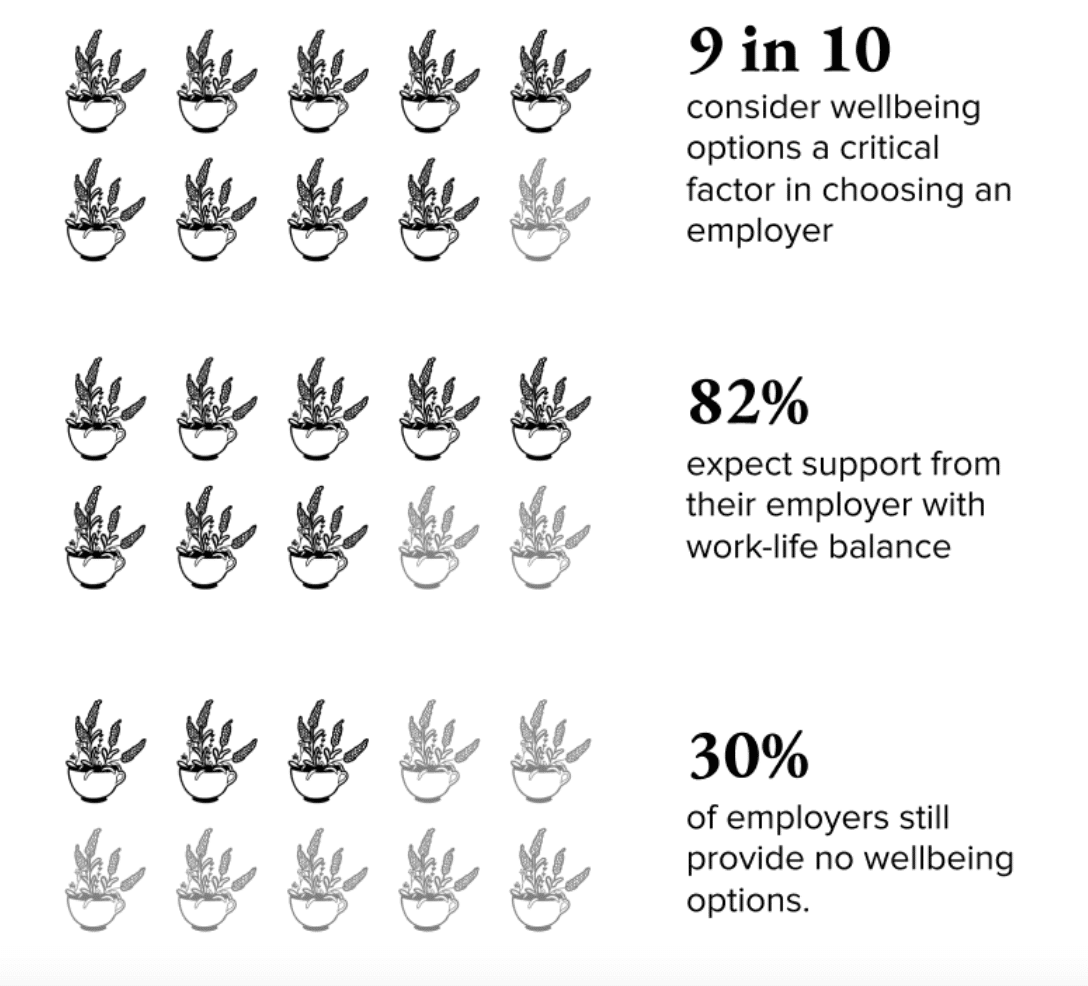
Offering wellbeing options isn’t just a ‘nice-to-have’ benefit for employers. Research shows there is a direct impact on the company’s bottom-line. When asked about the negative effects of workplaces where wellbeing was not prioritized, 25% of the respondents in our survey said such environments adversely affected their desire to stay at the company – half of respondents (50%) said they believed workers’ motivation would be most affected, followed by productivity (48%) and creativity (28%).
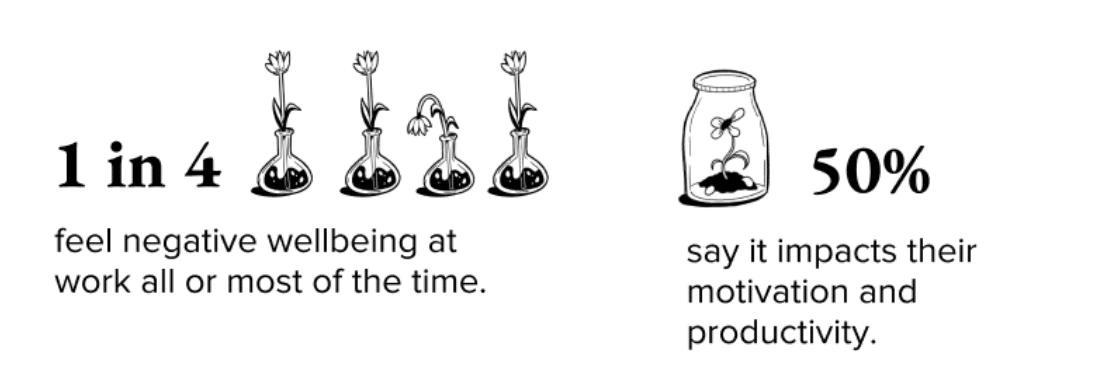
Mental Wellbeing
The World Health Organization estimates that 15% of the working-age population live with a mental health disorder, and that 12 billion working days are lost every year to depression and anxiety alone. Poor mental health affects a person’s confidence, productivity and ability to deal with stress. With mental health often an invisible illness, it can sometimes be tricky for employers to identify workers that need help. Fortunately, there are many guidelines today for what resources and support HR can provide to help employees fulfill their potential.
Work-related stress is one of the biggest causes of mental health issues – causing a drop in productivity, performance and an increase in fatigue, anxiety and depression. One of the most important steps to alleviate stress and mental health issues is for employers to ensure work-life balance. This could be encouraging employees to take their vacation time or offering mindfulness or yoga classes during work hours to reduce stress levels.
Many employers are beginning to provide access to either in-person or online therapists for workers and their close family. The global consulting giant Accenture, for example, offers multi-tiered employee health support, even including a wellbeing hub, chatbot for workers and their families, and even treatment for substance abuse. Offering a leave of absence for workers who are particularly struggling is also an excellent way to enable people to take care of whatever mental health problems they are experiencing.
Our survey results validated this by indicating the biggest causes of negative employee wellbeing were work overload, lack of sleep, poor work-life balance and also lack of recognition or reward for accomplishments. Although quantifying the exact economic impact of this is difficult, research by Gallup estimated that there is $322 billion in lost turnover due to employee burnout alone.
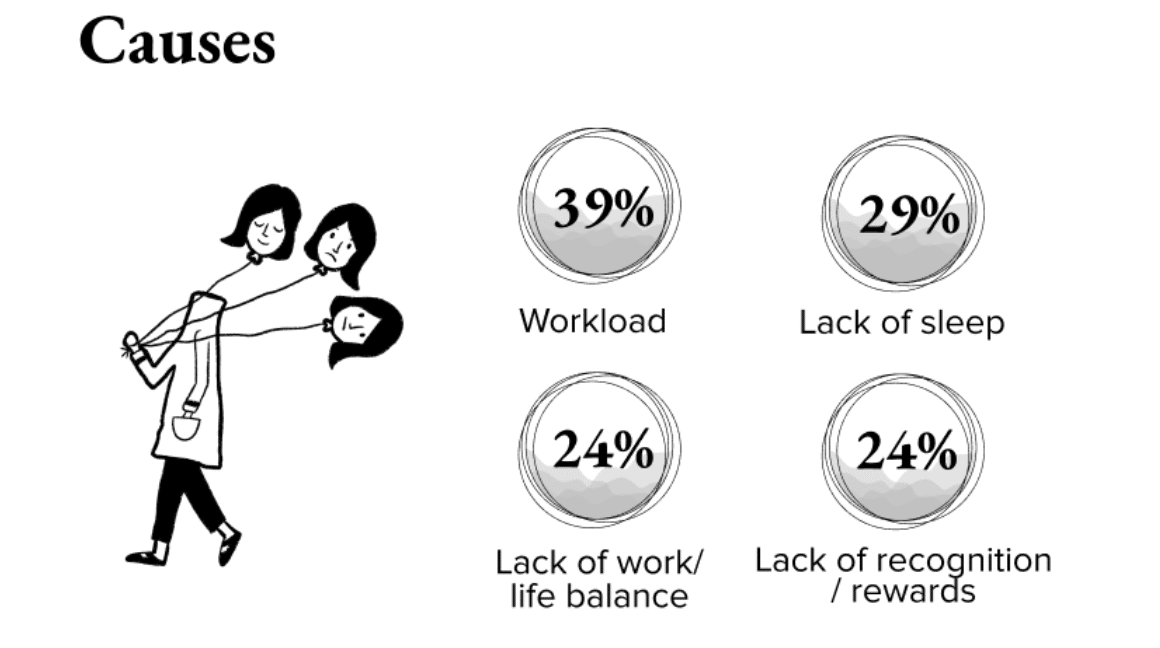
It’s true that employers cannot control factors that influence mental wellbeing outside of work, but they can take responsibility for providing resources and support, and cultivating an environment that encourages work-life balance. It’s an investment that has positive return-on-investment for companies, with a study by Oxford University showing that people are 13% more productive when happy.
Intuit is one company leading the way when it comes to stress reduction and mental health. It launched a ‘Fit for Life’ program that offers meditation classes and financial incentives for workers who participate in stress-reduction activities such as organized company walks, breathing exercises or listening to calming music. 25 Kent in Brooklyn, New York, playing host to coworking space Mindspace Williamsburg, offers meditation pods where members can unwind.
Physical wellbeing
Physical wellbeing is perhaps an easier challenge for employers to tackle, as there is greater awareness about how exercise, nutrition, sleep and relaxation positively impact our ability to function. Poor physical wellbeing among employees translates to higher absentee rates, increased healthcare costs and poor productivity. Over the past decade many workplaces have acknowledged its importance and begun offering fitness programs, nap rooms and healthy eating options. Setting the bar for healthy eating at work, Google, for example, is known for offering its employees in-house restaurants that offer nutritious meals. Also at Mindspace, a healthy breakfast is always a huge hit amongst our members for our happy hours.
A shift to remote work has made addressing the physical wellbeing of workers more challenging. Many employers, however, are adapting to provide virtual fitness classes, online wellness programs, and digital support groups to cater for remote workers, too.
Interestingly, for employers trying to get more workers back into the office, the respondents in our survey stated that a better selection of wellbeing services would serve as an effective incentive. This is particularly relevant for small-mid sized companies currently not offering anything to improve the physical health of their employees. Respondents in our survey said that the most desirable physical health amenities were an on-site gym, a swimming pool and yoga lessons.
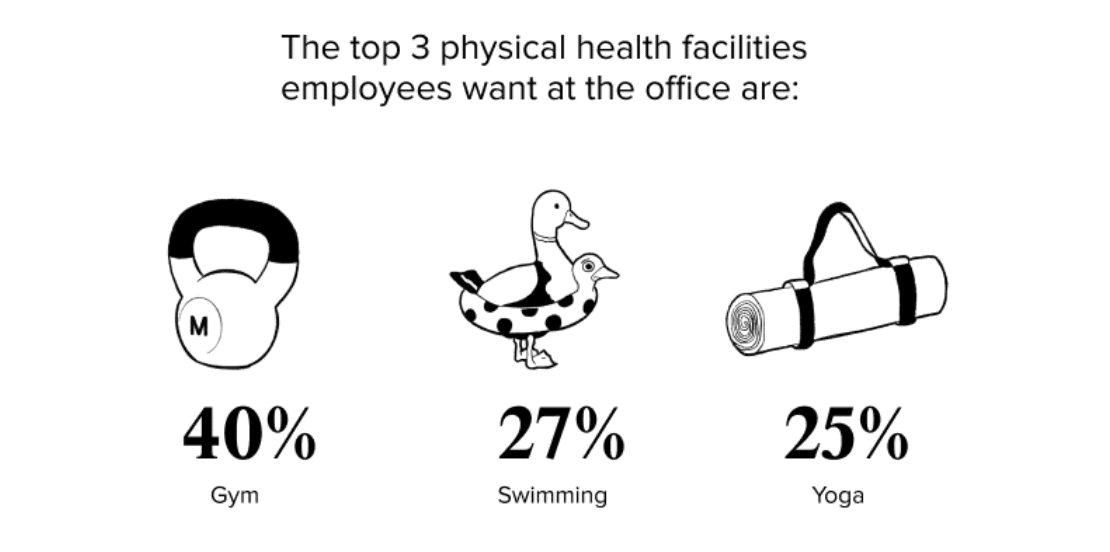
Also at our coworking space Mindspace Williamsburg in New York, members can find a range of wellbeing facilities – including a state-of-the-art gym, a climbing wall, yoga lessons, the ability to bike to work, as well as a beautifully designed space full of natural light, to help boost any worker’s mood and creativity. It’s a great example of how to integrate wellbeing into the workday. In addition, our coworking space in Wynwood, Miami, has similar fitness amenities to help address work-life balance and help boost mental and physical health of workers – including a climbing wall and a rooftop to practice yoga and pilates and to sip morning smoothies.
Financial wellbeing
Financial wellbeing refers to employees being able to meet their current expenses and to feel secure about their financial future. This includes at the very least a basic understanding of finances – and how to budget, save and invest wisely. The rise in cost of living, the COVID-19 pandemic, regional conflicts and other global challenges have accelerated negative financial wellbeing worldwide. The CIPD organization in the UK states that up to one in eight workers experiences ‘significant financial distress and the very real risks and growth of in-work poverty’, showing that many employees are already struggling to cope.
Employers can play an important role in improving the financial wellbeing of their workforce. They can go beyond the basic educational workshops and retirement plans to coach their employees on financial tactics such as establishing emergency saving funds and debt reduction, and provide legal and mortgage advice, educational subsidies and even on-site childcare for workers.
Social wellbeing
Feeling connected to peers and leaders in the workplace can have a dramatic impact on social wellbeing. Workers who feel a sense of belonging are more likely to report higher levels of employee engagement and are less likely to leave. There are many ways employers can foster an inclusive culture that encourages friendship, emotional support and relationship building – such as team bonding exercises, volunteering days and company lunches.
There are certainly numerous tactics used to boost productivity in the short-term, but improved employee morale has been proven to boost employee engagement and productivity in the long-run. So managers should explore ways for their teams to simply have fun together – and they’ll witness a sustained impact on collaboration and creativity.
Career wellbeing
It’s a no-brainer that if you don’t like what you do, then it’s going to impact your ability to thrive. Employees who feel mismatched to their career are unlikely to feel satisfaction – as are workers who feel their career is stagnating. Conversely, according to research by Gallup, people with positive career wellbeing are more than twice as likely to be flourishing in their overall lives.
Career wellbeing is influenced by a broad range of factors including having meaning or purpose at work, professional progression, supportive and empathetic management and work-life balance. There are numerous measures employers can take to improve career wellbeing, including coaching, skills development, and regular one-to-one reviews. In our own survey, 24% of respondents stated that lack of recognition or rewards was one of the main contributors of negative wellbeing. This presents a clear action item to employers – namely to publicly acknowledge and reward the hard work and accomplishments of individuals in their team. This type of shout-out can validate an employee’s self worth, boost team morale and motivate workers to go the extra mile.
Empathetic leadership is the ability to listen, understand and accommodate employee needs, and is an important component of employee wellbeing. Research by Ernst & Young exploring reasons behind the Great Resignation showed that ‘over half (54%) of US workers say they have left a previous job because their boss wasn’t empathetic to their struggles at work. A similar number (49%) quit due to a lack of appreciation of pressures in their home life.’ This shows a staggering correlation between leadership style and employee retention.
What’s the number one thing employers can do to improve employee wellbeing?
When it comes to tackling absenteeism, retention and improving overall work-life balance, offering flexible workplace options is the most important element in any corporate wellbeing program. Giving employees the freedom to choose when and where they want to work reduces stress and boosts productivity – and is the single most effective way to improve both their physical and mental health. Topping our own survey results, it was followed by a shorter working week, more healthy eating options and the desire to have social encounters with coworkers.
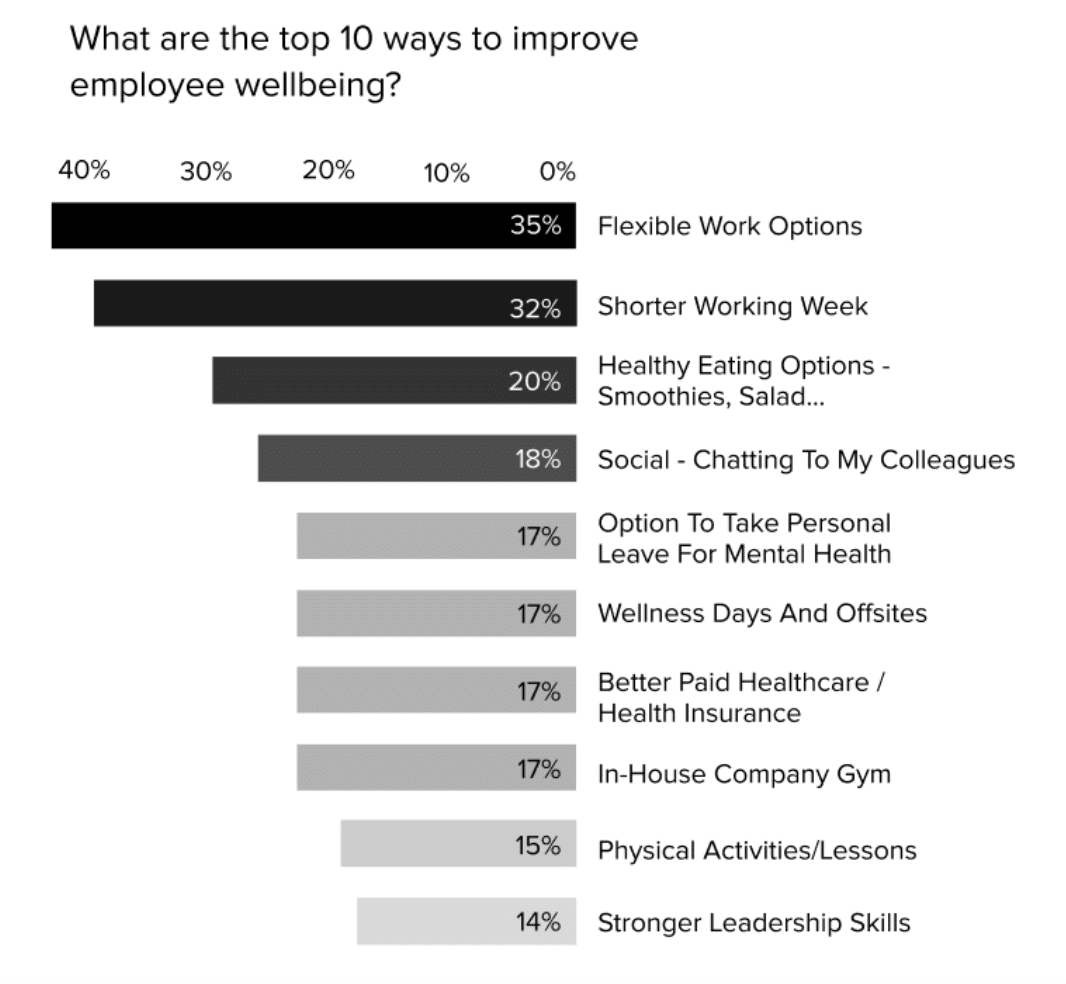
How to create an effective employee wellbeing program
When creating an employee wellbeing program, a good place to start is to outline the goals of the company’s wellbeing strategy and ensure that management are truly committed to these. A next step will be to take the time to understand the needs of the workforce by running a company-wide wellbeing survey and listening to feedback. If there isn’t sufficient space or resources to deliver the desired wellbeing initiatives, it’s worth turning to third party providers. Lastly – it’s important for employers to maintain communication with employees regarding their evolving needs and measure the impact of their efforts. Based on numerous industry studies, including our own survey, organizations will see a positive improvement across a multitude of business metrics. At Mindspace we implemented a range of wellbeing initiatives to boost employee health and morale, and continue to strive to better understand how we can support our most precious assets – our people.
Flexibility is key to employee wellbeing
While there is greater awareness about the importance of employee wellbeing and the impact it ultimately generates on a company’s bottom line, we still have a long way to go. Despite some larger multinationals making sizable investments in wellbeing initiatives, data shows that there is still a mental health crisis in the corporate world. In fact, our own survey insights show that one in four people feel negative wellbeing at work all or most of the time. Companies that don’t already have an employee wellbeing program and strategy in place should consider at the very least embracing a flexible work model and introducing healthy team lunches as a step in the right direction. We are happy to share additional insights in our full report on employee wellbeing.
Flex-office and coworking spaces such as our Miami coworking can provide an economical and flexible solution for employee wellbeing. At Mindspace we support a diverse range of companies, many of whom operate a hybrid working model. From our vibrant coworking community to our extensive fitness programs, we have all the vital ingredients to boost the physical and mental health of all our members. If you’re interested in exploring how we can help you and your team feel excited about coming into the office – and return home feeling healthy and energized, please get in touch with our team.



